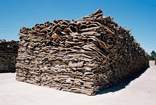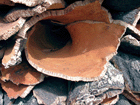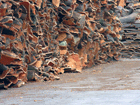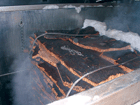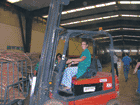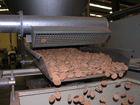

History,
Production, TCA Issues & Solutions
Story
By Bob Ecker
Photographs By: fellow travelers Bob Ecker, Mike Walsh,
Roger Archey
Portugal:
Portugal, at the far southwestern corner of Europe has
been producing wine for a long, long time. Vineyard
planting really took off after the Reconquista, which
ended in 1249, where the Portuguese and Spanish took
back the lands from the anti-alcohol Moors. The rise
of wine and the symbiotic Portuguese cork as an efficient
bottle closure has been of vital interest to the Portuguese
economy, as well as the International Wine industry
today.
WHAT
IS CORK?
First of all, you may ask, what exactly IS cork and
where does it come from? Cork is a natural product that
comes from the thick bark of a Cork Oak, or technically,
the Quercus suber L. tree. These trees are related to
others such as beech and chestnut, yet no other tree
on earth produces such a thick, resistant bark as the
Quercus. These trees have their roots, quite literally
in the Mediterranean and are still harvested in Spain,
North Africa and Italy. You may even see a few Cork
Oaks here and there in California. But Portugal by far,
leads the way in the husbandry of the trees and production
of cork. Today Portugal produces more than 50% of the
world's output of cork products, and employs over 60,000
people in this industry. Wine closures comprise Cork's
most visible role, but the product is also used in shoes,
gaskets, flooring, paneling and many other industrial
uses.
|
Click
on Image for caption and to enlarge |
HISTORY:
Although the product has been around forever, cork has
a long and colorful history indelibly linked to wine.
Pierre “Dom" Perignon, (born in 1638) a Benedictine
Monk at the Abbey of Hautville near Riems, experimented
with sparkling wines in the latter part of the Seventeenth
century. Though some were produced before him, Dom Perignon's
work produced a standard and process for the production
of Champagne, and also established the use of cork stoppers
as effective closures. The entire cork industry owes
a massive debt of gratitude to that wonderful monk.

ABOUT
CORK TAINT:
Some years ago, the term “corked" or ruined
wine became a serious economic problem to the wine industry.
It was estimated that between five and eight out of
every 100 wine bottles had “cork taint" and
were spoiled. Most of the evidence at the time blamed
the humble cork for introducing harmful elements to
wine, primarily TCA, which often contaminated the final
product. In the nineties, many new wine bottle closures
came into being, ones whose use, it was claimed, would
eliminate tainted wine. The most well known alternate
closures are screw caps and synthetic corks. The worldwide
wine industry seriously studied alternative closure
as did the cork industry, whose main product was under
serious attack. Fortunately, quite a bit of hard scientific
data has been conducted on wine, corks, TCA and various
types of modern closures. The results are far from complete,
but recent studies suggest that the conventional cork
is here to stay. "I believe the best closure for
a great wine is a high quality natural cork," said
Tom Selfridge, the President of Napa's Hess Collection
Winery.
TCA:
TCA, what is it? TCA (2, 4, 6 Trichloroanisole) is an
organically occurring chemical compound that can cause
off-putting, musty, moldy odors and flavors in wine.
Most people will not notice TCA unless a wine has it
in high levels. Ironically TCA is found in tap water,
orange juice, beer, bananas, paper and many other common
products. But TCA has become a buzzword in the wine
industry. Getting rid of it has been the prime challenge
for the cork producers, and it appears that the problem
has been solved.
THE
SOLUTION:
The Cork industry and the Amorim Cork Company in particular
(the single largest cork producer in the world) has
thoroughly examined TCA and “cork taint"
issues, and is among the world leaders in eliminating,
or mitigating free TCA molecules associated with cork
production. Basically, this Portuguese company has spent
millions of Euros (Over $43 million invested since 2000)
understanding the original problem, then rectifying,
modernizing, updated, streamlining, and instituting
tremendous quality control mechanisms into the production
line; all the while re-educating the public regarding
the most effective wine bottle closure on earth: the
cork.
Visiting
an Amorim cork plant is amazing. Eleven hundred people
are employed at the largest Portuguese cork factory.
This scientifically clean environment helps to eliminate
any opportunities for TCA to infect the final, finished
corks.
The
cork is delivered to the factory and is stacked in the
open air on a drainable cement surface to prevent contact
with the earth. After 6 or more months of open air seasoning,
the cork is ready for sorting and boiling.
Then,
the pallets of cork are gently boiled for approximately
one hour to remove organic solids and bring the moisture
content to around 14%.
Next, pieces are hand sorted. In fact, only about 30%
of the best wood ends up as a wine stopper. Next, pieces
of bark are then cut into smaller pieces, and sorted
by size, thickness and color. The pieces are sorted
and cut, sorted and cut, sorted and cut. Planks go to
different areas of the factory for varying types and
sizes of corks. At each stage, men and women are constantly
examining pieces of cork for all sorts of defects and
discarding rejects. Much of that wood is recycled, used
for flooring or is ground up and utilized as fuel for
the plant itself.
Natural
Corks are “punched," by men working a leg
activated punch. Since this is an entirely natural product,
the men have to look at each 15 inch piece of wood and
move it slightly left or right, up or down based upon
the grain and unique characteristics in the wood. Each
piece of wood bark yields about 9 corks.
After
the whole corks and disks are punched, they go through
an extensive sorting, washing and polishing process
that involves computerized photo sorting as well as
careful examination by teams of trained workers. Once
the cork have been graded and tested for TCA and other
contaminants, they are ready for custom printing and
coating. Amorim produces over 3 billion corks each year
making them the largest producer of natural wine cork
closures in the world.
|
Cork
Disks used for Twin Tops and Sparkling Wine Closures |
There
are other closures out there, and they do have their
uses, particularly for inexpensive wine products. But
corks clearly do the job wonderfully, sealing wine from
the elements and also allowing for trace amounts of
contact between wine and oxygen, a vital link that promotes
effective, slow aging of wine in the bottle. Again,
Hess Selfridge is adamant. “The synthetic corks
let too much air in, and screw caps let none in. Natural
cork allows just the amount of air in to let the wine
age well."
Simply
put, cork is natural product involving careful forest
management techniques, employs thousands and today utilizes
state-of-the-art quality control methods that ultimately
produce the type of closure I want on a wine bottle.
With TCA under control, cork's elegant romance, corkscrew
twist and lovely “pop" is surely the way
to unquestionably enjoy a fabulous bottle of wine.





